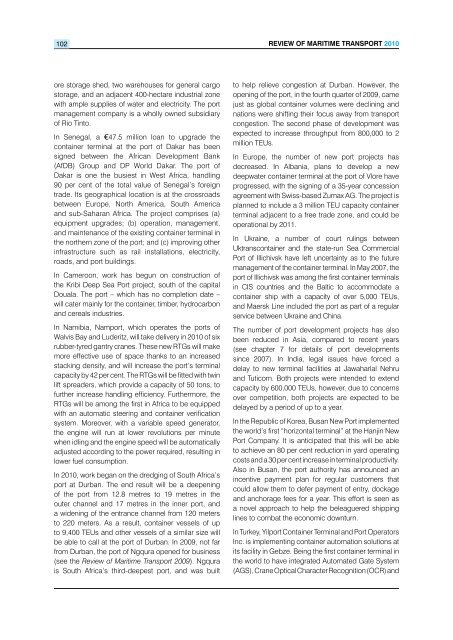Review of Maritime Transport 2010 - Unctad
Review of Maritime Transport 2010 - Unctad
Review of Maritime Transport 2010 - Unctad
You also want an ePaper? Increase the reach of your titles
YUMPU automatically turns print PDFs into web optimized ePapers that Google loves.
102<br />
ore storage shed, two warehouses for general cargo<br />
storage, and an adjacent 400-hectare industrial zone<br />
with ample supplies <strong>of</strong> water and electricity. The port<br />
management company is a wholly owned subsidiary<br />
<strong>of</strong> Rio Tinto.<br />
In Senegal, a 47.5 million loan to upgrade the<br />
container terminal at the port <strong>of</strong> Dakar has been<br />
signed between the African Development Bank<br />
(AfDB) Group and DP World Dakar. The port <strong>of</strong><br />
Dakar is one the busiest in West Africa, handling<br />
90 per cent <strong>of</strong> the total value <strong>of</strong> Senegal’s foreign<br />
trade. Its geographical location is at the crossroads<br />
between Europe, North America, South America<br />
and sub-Saharan Africa. The project comprises (a)<br />
equipment upgrades; (b) operation, management,<br />
and maintenance <strong>of</strong> the existing container terminal in<br />
the northern zone <strong>of</strong> the port; and (c) improving other<br />
infrastructure such as rail installations, electricity,<br />
roads, and port buildings.<br />
In Cameroon, work has begun on construction <strong>of</strong><br />
the Kribi Deep Sea Port project, south <strong>of</strong> the capital<br />
Douala. The port – which has no completion date –<br />
will cater mainly for the container, timber, hydrocarbon<br />
and cereals industries.<br />
In Namibia, Namport, which operates the ports <strong>of</strong><br />
Walvis Bay and Luderitz, will take delivery in <strong>2010</strong> <strong>of</strong> six<br />
rubber-tyred gantry cranes. These new RTGs will make<br />
more effective use <strong>of</strong> space thanks to an increased<br />
stacking density, and will increase the port’s terminal<br />
capacity by 42 per cent. The RTGs will be fitted with twin<br />
lift spreaders, which provide a capacity <strong>of</strong> 50 tons, to<br />
further increase handling efficiency. Furthermore, the<br />
RTGs will be among the first in Africa to be equipped<br />
with an automatic steering and container verification<br />
system. Moreover, with a variable speed generator,<br />
the engine will run at lower revolutions per minute<br />
when idling and the engine speed will be automatically<br />
adjusted according to the power required, resulting in<br />
lower fuel consumption.<br />
In <strong>2010</strong>, work began on the dredging <strong>of</strong> South Africa’s<br />
port at Durban. The end result will be a deepening<br />
<strong>of</strong> the port from 12.8 metres to 19 metres in the<br />
outer channel and 17 metres in the inner port, and<br />
a widening <strong>of</strong> the entrance channel from 120 meters<br />
to 220 meters. As a result, container vessels <strong>of</strong> up<br />
to 9,400 TEUs and other vessels <strong>of</strong> a similar size will<br />
be able to call at the port <strong>of</strong> Durban. In 2009, not far<br />
from Durban, the port <strong>of</strong> Ngqura opened for business<br />
(see the <strong>Review</strong> <strong>of</strong> <strong>Maritime</strong> <strong>Transport</strong> 2009). Ngqura<br />
is South Africa’s third-deepest port, and was built<br />
<strong>Review</strong> <strong>of</strong> MaRitiMe tRanspoRt <strong>2010</strong><br />
to help relieve congestion at Durban. However, the<br />
opening <strong>of</strong> the port, in the fourth quarter <strong>of</strong> 2009, came<br />
just as global container volumes were declining and<br />
nations were shifting their focus away from transport<br />
congestion. The second phase <strong>of</strong> development was<br />
expected to increase throughput from 800,000 to 2<br />
million TEUs.<br />
In Europe, the number <strong>of</strong> new port projects has<br />
decreased. In Albania, plans to develop a new<br />
deepwater container terminal at the port <strong>of</strong> Vlore have<br />
progressed, with the signing <strong>of</strong> a 35-year concession<br />
agreement with Swiss-based Zumax AG. The project is<br />
planned to include a 3 million TEU capacity container<br />
terminal adjacent to a free trade zone, and could be<br />
operational by 2011.<br />
In Ukraine, a number <strong>of</strong> court rulings between<br />
Uktranscontainer and the state-run Sea Commercial<br />
Port <strong>of</strong> Illichivsk have left uncertainty as to the future<br />
management <strong>of</strong> the container terminal. In May 2007, the<br />
port <strong>of</strong> Illichivsk was among the first container terminals<br />
in CIS countries and the Baltic to accommodate a<br />
container ship with a capacity <strong>of</strong> over 5,000 TEUs,<br />
and Maersk Line included the port as part <strong>of</strong> a regular<br />
service between Ukraine and China.<br />
The number <strong>of</strong> port development projects has also<br />
been reduced in Asia, compared to recent years<br />
(see chapter 7 for details <strong>of</strong> port developments<br />
since 2007). In India, legal issues have forced a<br />
delay to new terminal facilities at Jawaharlal Nehru<br />
and Tuticorn. Both projects were intended to extend<br />
capacity by 600,000 TEUs, however, due to concerns<br />
over competition, both projects are expected to be<br />
delayed by a period <strong>of</strong> up to a year.<br />
In the Republic <strong>of</strong> Korea, Busan New Port implemented<br />
the world’s first “horizontal terminal” at the Hanjin New<br />
Port Company. It is anticipated that this will be able<br />
to achieve an 80 per cent reduction in yard operating<br />
costs and a 30 per cent increase in terminal productivity.<br />
Also in Busan, the port authority has announced an<br />
incentive payment plan for regular customers that<br />
could allow them to defer payment <strong>of</strong> entry, dockage<br />
and anchorage fees for a year. This effort is seen as<br />
a novel approach to help the beleaguered shipping<br />
lines to combat the economic downturn.<br />
In Turkey, Yilport Container Terminal and Port Operators<br />
Inc. is implementing container automation solutions at<br />
its facility in Gebze. Being the first container terminal in<br />
the world to have integrated Automated Gate System<br />
(AGS), Crane Optical Character Recognition (OCR) and

















